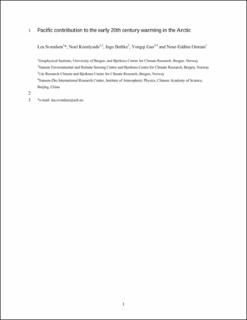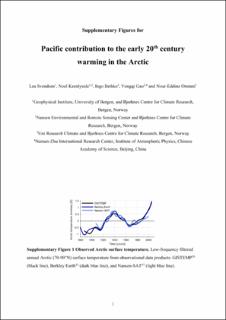| dc.contributor.author | Svendsen, Lea | |
| dc.contributor.author | Keenlyside, Noel | |
| dc.contributor.author | Bethke, Ingo | |
| dc.contributor.author | Gao, Yongqi | |
| dc.contributor.author | Omrani, Nour-Eddine | |
| dc.date.accessioned | 2022-01-31T08:29:11Z | |
| dc.date.available | 2022-01-31T08:29:11Z | |
| dc.date.created | 2018-08-06T19:19:18Z | |
| dc.date.issued | 2018 | |
| dc.identifier.issn | 1758-678X | |
| dc.identifier.uri | https://hdl.handle.net/11250/2975809 | |
| dc.description.abstract | Arctic surface temperature warmed more than twice as fast as global temperature during the early twentieth century, similar to that during the recent global warming. This Arctic warming has been attributed to both external forcing1 and internal variability associated with atmospheric dynamics2,3 and Atlantic Ocean temperature4 in combination with Pacific variability5. Here we show, through coupled climate model experiments that superpose externally forced and dynamically driven changes, that Pacific decadal variability alone was a key contributor to the early twentieth century Arctic warming. Sea surface temperatures in the model are phased to observations by prescribing historical wind variations over the Pacific, which drive thermodynamically consistent decadal variations. During the early twentieth century, the Pacific Decadal Oscillation (PDO) transitioned to a positive phase with a concomitant deepening of the Aleutian Low that warms the Arctic by poleward low-level advection of extratropical air. In addition, our experiments revealed that the implemented Pacific surface changes weaken the polar vortex, which leads to subsidence-induced adiabatic heating of the Arctic surface. Thus, our results suggest that the observed recent shift to the positive PDO phase6 will intensify Arctic warming in the forthcoming decades. | en_US |
| dc.language.iso | eng | en_US |
| dc.publisher | Nature | en_US |
| dc.relation.uri | https://www.nature.com/articles/s41558-018-0247-1 | |
| dc.title | Pacific contribution to the early twentieth-century warming in the Arctic | en_US |
| dc.type | Journal article | en_US |
| dc.type | Peer reviewed | en_US |
| dc.description.version | acceptedVersion | en_US |
| dc.rights.holder | Copyright 2018 The Author(s) | en_US |
| cristin.ispublished | true | |
| cristin.fulltext | postprint | |
| cristin.fulltext | original | |
| cristin.qualitycode | 2 | |
| dc.identifier.doi | 10.1038/s41558-018-0247-1 | |
| dc.identifier.cristin | 1600062 | |
| dc.source.journal | Nature Climate Change | en_US |
| dc.source.pagenumber | 793-797 | en_US |
| dc.relation.project | Notur/NorStore: nn9039k | en_US |
| dc.relation.project | Norges forskningsråd: 229774 | en_US |
| dc.relation.project | EC/H2020/648982 | en_US |
| dc.relation.project | Andre: JPI-Climate/Belmont Forum project InterDec | en_US |
| dc.relation.project | Notur/NorStore: ns9039k | en_US |
| dc.relation.project | Notur/NorStore: NS9039K | en_US |
| dc.relation.project | Andre: JPI-CLIMATE/BELMONT FORUM PROJECT INTERDEC | en_US |
| dc.relation.project | Notur/NorStore: NN9039K | en_US |
| dc.identifier.citation | Nature Climate Change. 2018, 8, 793-797. | en_US |
| dc.source.volume | 8 | en_US |

